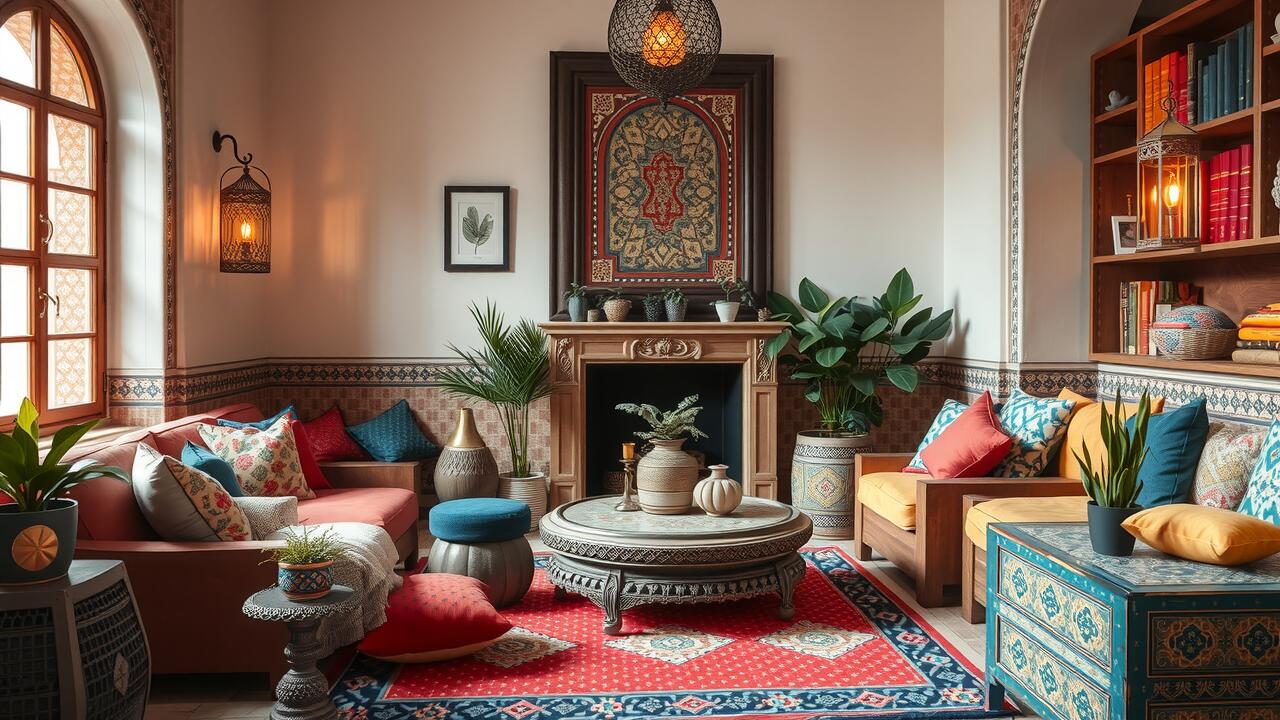
The Impact of Yellow in Moroccan Decor
In Moroccan decor, yellow emerges as a vibrant and energetic color that infuses spaces with warmth and optimism. This hue often takes center stage in various elements, from wall paints to ceramic tiles. Its brightness can evoke feelings of joy and creativity, making it an ideal choice for living areas and communal spaces. In textiles, yellow patterns can serve as eye-catching focal points, harmonizing beautifully with the rich earth tones frequently found in this style.
The versatility of yellow allows it to complement other colors often used in Moroccan design. Whether paired with deep blues, bold reds, or muted neutrals, yellow adds a layer of liveliness that enhances the overall aesthetic. Its presence can be subtle or striking, depending on the design choices made. Incorporating yellow accents, such as in cushions, pottery, or artwork, helps create an inviting atmosphere, reminding viewers of the sun-drenched landscapes of Morocco.
Navigate to this website to learn more.
Creating Bright and Inviting Spaces
Vibrant yellows are a hallmark of Moroccan design, infusing spaces with warmth and energy. This cheerful hue can be seen in textiles, ceramics, and wall finishes, creating an inviting atmosphere that encourages social interaction. Whether it's painted walls or richly patterned cushions, yellow enhances the overall aesthetic by reflecting light and creating a sense of openness.
Incorporating yellow into a room often involves balancing it with other colors and textures. Against a backdrop of rich blues or earthy browns, yellow stands out, drawing the eye and elevating the mood of the space. Layering accessories, such as throw pillows or vibrant artwork, helps maintain a harmonious environment while ensuring that the boldness of yellow doesn’t become overwhelming.
Subtle Whites and Creams in Moroccan Design
In Moroccan design, whites and creams play a vital role in creating a serene foundation. These colors act as a canvas that allows other vibrant hues to stand out. When used in textiles, ceramics, and architectural details, they provide a fresh and airy ambiance. Light colors also reflect the natural sunlight, enhancing the spaciousness of interiors and exteriors alike.
Balancing the bold colors of Moroccan decor, whites and creams promote a sense of calm. They serve as a backdrop to intricate tilework and bold furnishings, grounding the overall design. By incorporating subtle whites and creamy tones, designers can achieve a harmonious blend of rustic charm and modern elegance, making spaces feel inviting and warm without overwhelming the senses.
Balancing Bold Colors with Neutrals
In Moroccan design, bold colors often take center stage, making a striking impact in any space. Rich reds, deep blues, and vibrant yellows provide a lively backdrop, embodying the spirit of Moroccan culture. To prevent these intense hues from overwhelming a room, neutral tones play a pivotal role. Whites, creams, and soft beiges create a calming balance that allows bold colors to shine while maintaining an inviting atmosphere.
The interplay between vibrant shades and subtle neutrals offers a sense of harmony that is essential in Moroccan interiors. Utilizing natural materials such as wood and stone in lighter hues can enhance this balance, adding depth and texture to the design. By thoughtfully integrating neutral tones alongside rich colors, designers can cultivate spaces that feel both dynamic and serene, inviting warmth and comfort.
The Allure of Patterns and Color Combinations
Moroccan design is known for its vibrant patterns that weave together cultural stories and traditions. From intricate tile work to embroidered textiles, each element plays a crucial role in creating a visually engaging environment. Geometric shapes and floral motifs frequently appear, representing a rich artistic heritage. The combination of these designs often enhances the depth and character of spaces, making them feel more alive.
Color combinations in Moroccan decor are equally striking, as they are deliberately chosen to evoke warmth and personality. Rich blues, fiery reds, and earth tones frequently blend with softer pastels, creating a dynamic yet harmonious palette. This interplay of colors is not merely for aesthetics; it reflects the diverse landscapes and rich history of Morocco. Each combination tells its own story, inviting a sense of exploration and appreciation for the culture.
Exploring Traditional Moroccan Motifs
Rich in history and cultural significance, traditional Moroccan motifs represent the fusion of various influences. Geometric patterns often take center stage, showcasing intricate designs that reflect the country’s diverse heritage. These shapes are more than mere aesthetics; they symbolize unity and harmony. Vibrant tessellations can be seen in tile work, textiles, and architectural elements, creating a visual feast that draws the eye.
Floral and arabesque designs also play a prominent role in Moroccan art. These organic forms bring an element of nature indoors, often interwoven with bold colors that create depth and texture. Each motif tells a story, connecting the observer to Morocco’s past while celebrating its vibrant present. The careful combination of shapes and colors transforms spaces into rich narratives, inviting viewers to explore the layered meanings behind each design.
FAQS
What are the primary colors used in Moroccan design?
The primary colors used in Moroccan design include vibrant hues such as yellow, red, blue, and green, often balanced with neutral shades like white and cream.
How does yellow influence Moroccan decor?
Yellow in Moroccan decor is known for creating bright and inviting spaces, often used to bring warmth and cheerfulness to a room.
Why are whites and creams important in Moroccan design?
Whites and creams act as a balancing element in Moroccan design, helping to tone down bold colors and create a harmonious and serene atmosphere.
What is the significance of patterns in Moroccan color schemes?
Patterns are a key aspect of Moroccan design, often featuring intricate motifs that combine various colors, enhancing the overall aesthetic and cultural richness of the space.
Can you mix bold colors in Moroccan design?
Yes, mixing bold colors is common in Moroccan design; however, it's important to balance them with neutral tones to prevent overwhelming the space.